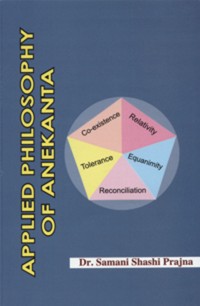The entire knowledge of a thing at a particular spatio-temporal locus is conditional and relative to the circumstance.[1] The eminent philosopher Radhakrishnan[2] translates syādvāda, as the theory of relativity. Moreover he says, ‘the theory of relativity cannot be logically sustained without the hypothesis of an absolute. The fact that we are conscious of our relativity means that, we have to reach out to a fuller conception. It is from that higher absolute point of view that the lower relative ones can be explained.’
The founder of the theory of relativity, Albert Einstein explained his relativity through an interesting story. Mrs. Einstein didn’t understand her husband’s theories. One day she asked, “What shall I say is relativity?”. The thinker replied with an unexpected parable, “When a man talks to a pretty girl for an hour, it seems to him only a minute, but let him sit on a hot stove for only a minute and it is longer than an hour that is relativity.”
Anything bound by time and space, cannot be independent. Both are connected to our events. This is so because no event can be explained without time and space. We take the help of these two (specs) measures and explain events. Sometimes we have to refer to the place and sometimes to the time. Where to go; Right or left? Which is right and which is left, using any point as the reference, we can identify left or right? Otherwise there can be no left or right. Now it is 3.30 in the afternoon in Ladnun. Is it same time in Moscow too? No, it is daylight there. Day and night cannot be identified without the concept of relativity of space and time.
This epistemological and logical theory of the Jaina-s is called ‘syādvāda’. As a matter of fact, both anekāntavāda and syādvāda are the two aspects of the same teaching, realistic and relativistic pluralism. They are like the two sides of the same coin. The metaphysical side that reality has innumerable characters is called anekāntavāda, while the epistemological and logical side that we can know only some aspects of reality and therefore, all our judgments are necessarily relative, is called syādvāda.
Syādvāda can be explained to an ordinary person in a very simple manner. A Jain thinker, in explaining syādvād, raised his little finger and the next one and asked which is bigger? The right finger is bigger, no doubt was the answer. He then raised only the ring and the middle finger and then asked, which is smaller? The answer was the ring finger. He then said, it is syādvāda. The same finger is bigger and smaller both. Thus there is nothing absolutely bigger or smaller. Everything is relatively smaller or bigger. This is the Jain theory of relativity.
In this context, it is relevant to say that there is misconception regarding anekānta theory, that it expresses only relative truth and there is nothing like an absolute truth in Jain philosophy. To this Ācārya Mahāprajña replied in his text, ‘Jain Darśana Aur Anekānta,’ the existence of basic five substance(medium of motion, medium of rest,space,matter,soul) are absolute (nirpekṣa) truths.[3] Moreover, he says that, bereft of absolute, how can relative truth exist? This question was raised against anekānta but anekānta is also anekāntic. So C.D. Sharma in his book ‘A Critical Survey of Indian Philosophy’ says, the difficulty is that the nayas have not been woven together. The non-absolutism is the only thread,which can weave them together. In the absence of absolute, this synthesis is an impossible for Jainism. Even Jains accept the absolute truth. Mahāprajña says, without absolute truth, we cannot attain the relative truth. Due to misunderstanding of the nature of the theory, the above statements are made.[4]
Ācārya Mahāprajña cited an example of relativity through an instance of teacher and the student. The teachers told the student, shorten the line drawn on the black board without erasing any part of it. Now how is it possible to make it short and yet not rubbing a part of it? The student was intelligent, he drew a longer line thus making the original line appear shorter. Jain philosophy contends that no philosophic proposition can be true, if it is only unconditionally asserted.[5]
 Dr. Samani Shashi Pragya
Dr. Samani Shashi Pragya

